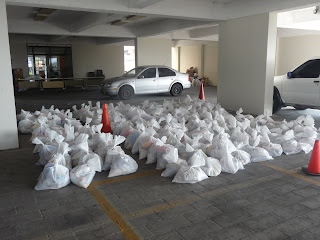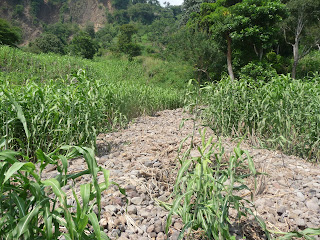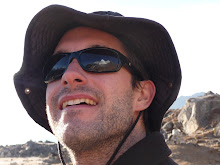n the days leading up to November 9th it started raining. And it didn’t stop. At one point, El Salvador received a month’s worth of rain in just four hours. As a result of Hurricane Ida and a low pressure system in the Pacific, the rains just kept battering El Salvador. As I hunkered down comfortably in my house in San Salvador cranking out my final project for VisionSpring – and to be honest enjoying the sound of the rain hitting my roof – I had no idea that communities were being destroyed as close as ten miles away.
The storms themselves did little damage, but the deluge of rain caused rivers to overflow and hillsides to collapse. Since so many El Salvadorans live along a river or at the base of mountains and volcanoes this spelled disaster. Roads were washed away, bridges collapsed, landslides crushed homes, crops were destroyed, and water infrastructure damaged. As of current count, 189 people died, another 80 are missing, and over 10,000 are homeless and living in shelters. It is the worst disaster in El Salvador since the 2001 earthquakes which killed over 1,000 people and displaced hundreds of thousands.
Here's a video that one of our club members put together about the disaster:
Like many other organizations, the Rotary Clubs of San Salvador have banded together to provide relief to those affected by the storms. I facilitated a donation by my sponsor club, the Rotary Club of Hamden, and then joined in on a humanitarian mission to provide bags of food to affected families. By now, most communities have received at least some assistance, but many families are still in dire straits. Most food rations bring provided last families at most a week and potable water runs out even more quickly. What is more, due to the floods and landslides some communities still cannot be reached by land.
As a result, El Salvador’s Air Force has played a critical role in the rescue and recovery efforts. They were the first to know of the unfolding tragedies – many communities were cut off when electricity and cell phone towers went down, but the Air Force does regular exercises to survey the country and so spotted the trouble – and were the first on the scene pulling people out of rivers and off of rooftops.
Allow me to digress briefly. The rescue and relief efforts are only part of and parcel of the expanded civil role the El Salvadoran military plays today. Something I haven’t had the chance to address yet in my blog is the President’s recent (and controversial) decision to use thousands of army personnel to support the national police in keeping the peace. Gang violence had risen to such unprecedented levels in October that the President chose to put the military back into the streets for the first time since they ransacked the countryside before and during the nation’s civil war (see various blogs including “Chalate” and “Perquin”, with more to follow on Monseignor Romero). Despite the terrible memories, most El Salvadorans were willing to turn a page on their history and tackle the country’s gang problem (see blog post “Las Pandillas”). But the military barely had the chance to get accustomed to their new role as law enforcers when they were called into action to respond to the national emergency.
Since one of the members of my host Rotary Club is married to the colonel in charge of overseeing the Air Force’s transport vehicles, we were able to take part in one of the Air Force’s many supply runs.

Rotaract Clubs assembled the supplies

The rest of us loaded up the truck

Rodrigo, Brando, Carlos and I pose at the Air Force Base
We were met at the Air Force Base by Lt. Colonel Villatoro, the spouse of Rotary Club member Claudia, and Colonel Angulo, the Commander of one of the Air Force’s two divisions.

Lt. Colonel shows us our destination on a map
Both gentlemen were modest but distinguished individuals who impressed me with their knowledge of rescue and recovery operations and genuine passion for humanitarian work. They seemed eager to help, and eager to show the constructive role that the Air Force is playing. Colonel Argulo and I swapped stories about our travels overseas. In particular, I appreciated his stories about his service in Baghdad during the first Gulf War. There he worked alongside servicemen and woman from around the world and the experience impressed upon him the value of speaking other languages. Without English, he and his fellow service members from all over the world would not have been able to communicate. Thus, he appreciated my efforts to learn Spanish.

Colonel Argulo's fly bag
After signing our lives away into release forms, we boarded a Huey, one of the iconic helicopters from the Vietnam era and our mode of transportation for the day. (After boarding and feeling the rush of the take-off, I decided that such helicopters should come with a build in CCR soundtrack.) The United States government has loaned El Salvador four helicopters for humanitarian missions, which the Air Force is putting to good use. The Colonel mentioned the Huey-Vietnam connection as well. Flying over the tropical landscape in the helicopter makes him think of “Heart of Darkness” or other Vietnam movies. The flight was exhilarating and the vistas beautiful.

Club President Carlos Pocosangre signing up for duty, Sir!

New Club member Renee and I pose before take-off

One of our Air Force guides looks out over the landscape

Unbelievable views from above Lake Illopango
And finally, here's a video of the first half of our flight:
[coming soon...]
But of course, the helicopter ride was only a means to an end. Our real purpose was to deliver provisions and to assess the situation on the ground in order to plan future missions. Over the course of the day we visited two communities, Paraiso de Osoria and San Rafael. We arrived in Paraiso (“Paradise”) and immediately received a briefing from the town’s mayor.

The Mayor of Paraiso meets us at the helicopter

And we brief each other in his office
We then proceeded to hand out the bags of food (there have been scattered stories of food being horded and distributed to political allies, so we were told we should distribute the food directly to the recipients). Our efforts at this time were directed only at people who had been forced from their homes (27 families in this small community), so the line in Paraiso was relatively short.

Families queue up for assistance

Colonel Argulo, Brando and Carlos get ready to give out bags
Next we visited the town’s water pump, a 15 minute drive down-hill. As we drove, we saw how rain water had torn through the earth, and how landslides had destroyed crops.

A landslide tears through crops outside of Paraiso
When we got to the river, we found that both the pipe that bring water to the pump and that which delivers water up-hill to three communities including Paraiso were broken.

The pipe to nowhere

People fill up from the broken water line to carry water back to their community - 15 min by car and much worse on foot

Making lemonade from lemons
For our next stop, we headed to San Rafael, a neighboring community. Like Paraiso, the relief efforts were well-organized. We visited a shelter where 59 families are being housed. Some of them lost their homes entirely and for others their homes are so precariously situated that they cannot return. Most return to their land to attend to their remaining crops and animals and sleep in the shelter at night. I had a nice conversation with a young woman, Sandra, and two of her four young children. Her home had been badly damaged by flooding and falling debris. We visited with the women who have been working week straight to cook and care for the displaced, and then we provided bags of food to each of the families. 
The Mayor of San Rafael briefs us at the homeless shelter
I am going to be collecting money to help with the recovery effort when I return home so please keep your eyes out. Rotary is going to continue to provide food and water, has acquired temporary homes for 300 families and will continue helping people rebuild their homes and lives for the long-term.





No comments:
Post a Comment